Airflow Modeling over a Flying Bird, CFD Simulation
Free
- Aerodynamic Engineering
- Aerodynamic Coefficients
To Order Your Project or benefit from a CFD consultation, contact our experts via email (info@mr-cfd.com), online support tab, or WhatsApp at +44 7443 197273.
There are some Free Products to check our service quality.
If you want the training video in another language instead of English, ask it via info@mr-cfd.com after you buy the product.
Description
Airflow Modeling over a Flying Bird, ANSYS Fluent CFD Simulation Training
In this project, we aim to investigate airflow modeling over a flying bird. The aerodynamic analysis could be inspiring for engineers to design more practical wings with better performance.
Methodology
The pressure-based solver is used because the working fluid (air) is incompressible. Also, the k-epsilon Realizable two-equation turbulence model is hired in order to capture the probable flow complexities and wakes.
Results
In this project, we investigated the airflow passing over a bird. the shapes of birds are in a way that it reduces the separation of the boundary layer, and enhance the lift generation so that the bird can fly through the air with the least effort. Based on the obtained data, the pressure distribution on the top surface of the wing (airfoil) is less than the pressure on the bottom face, due to the velocity of airflow being larger than that of the bottom surface. This pressure distribution will trigger the generation of lift force on the bird’s wings.
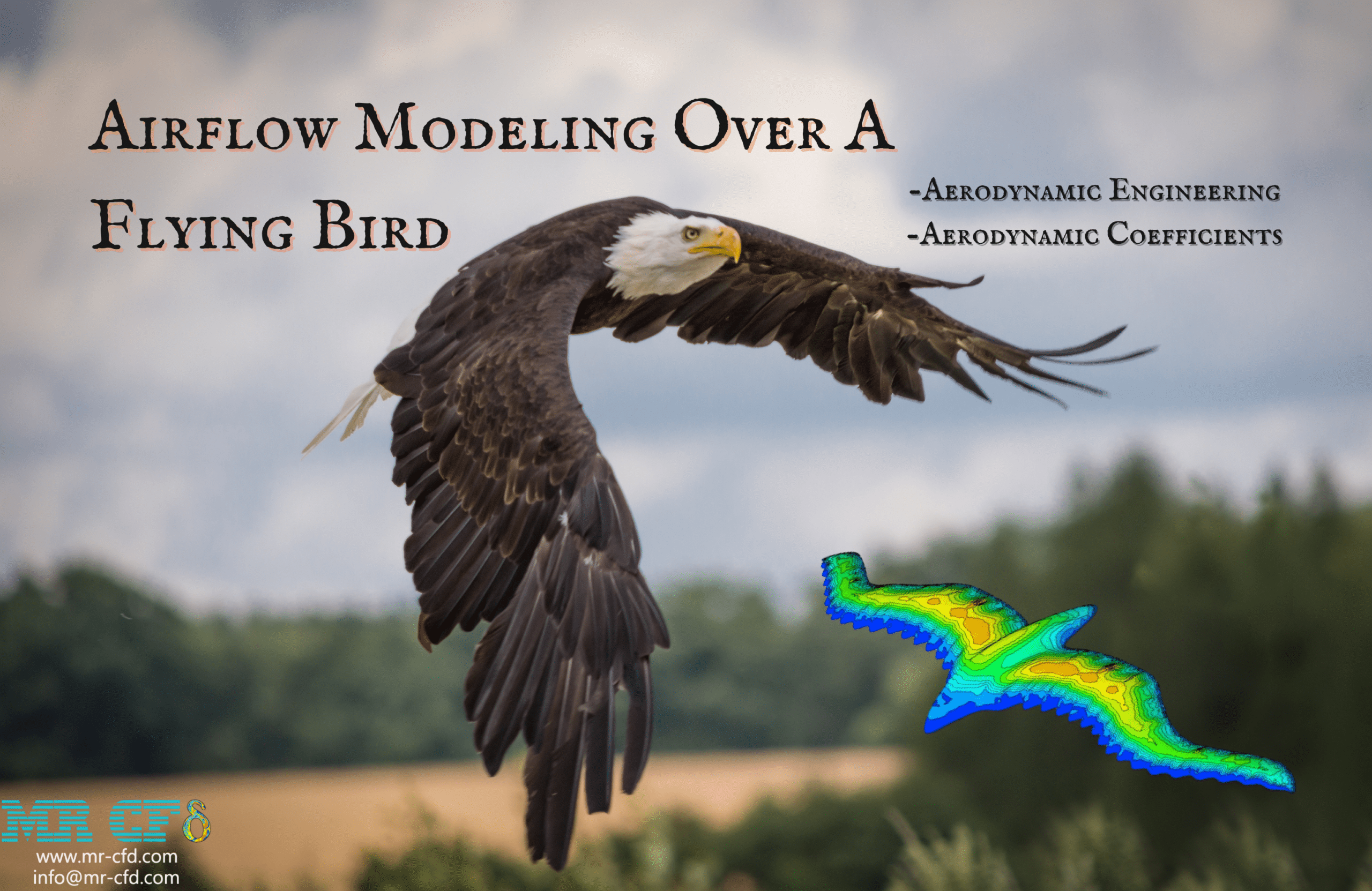
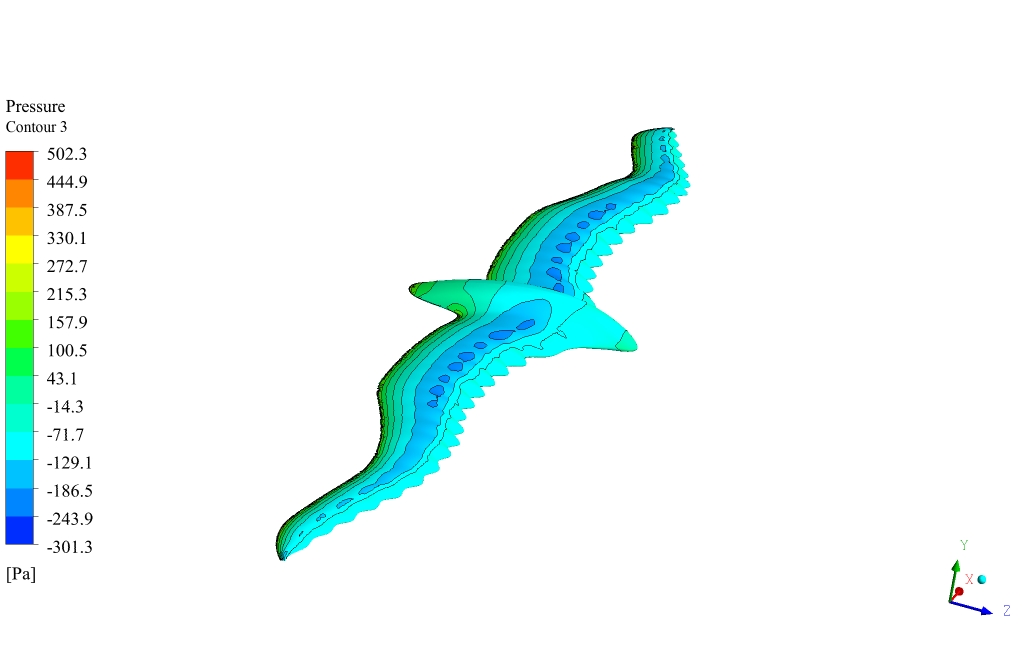
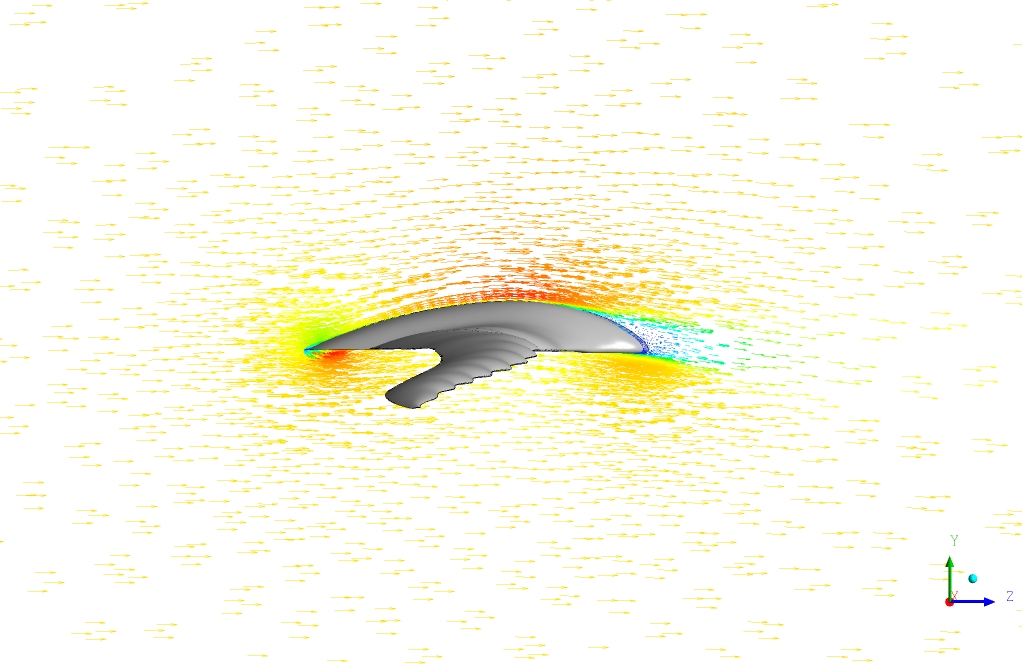
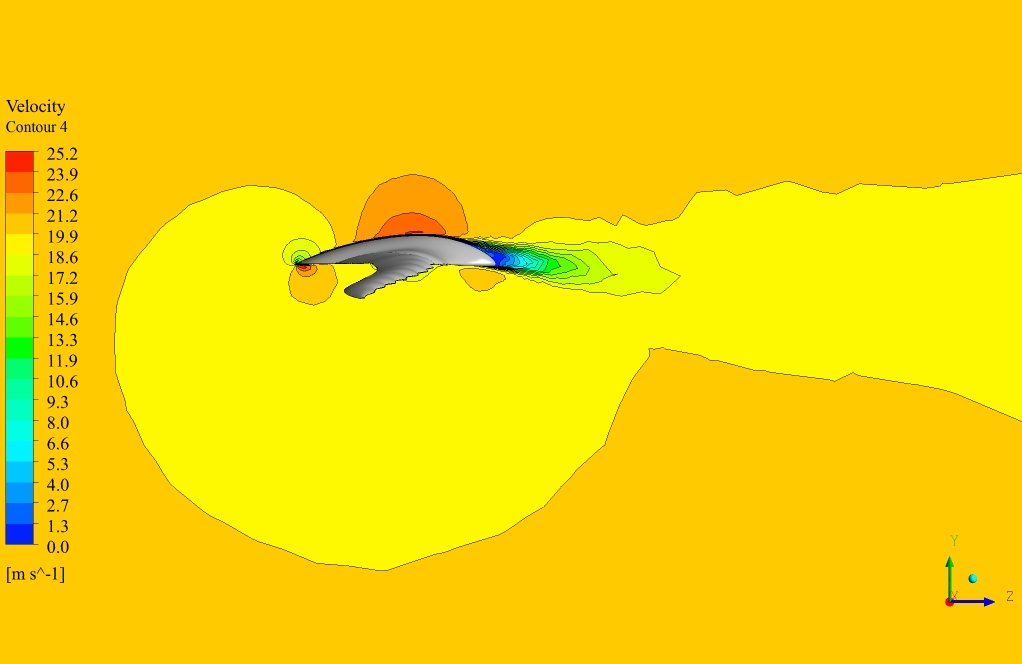
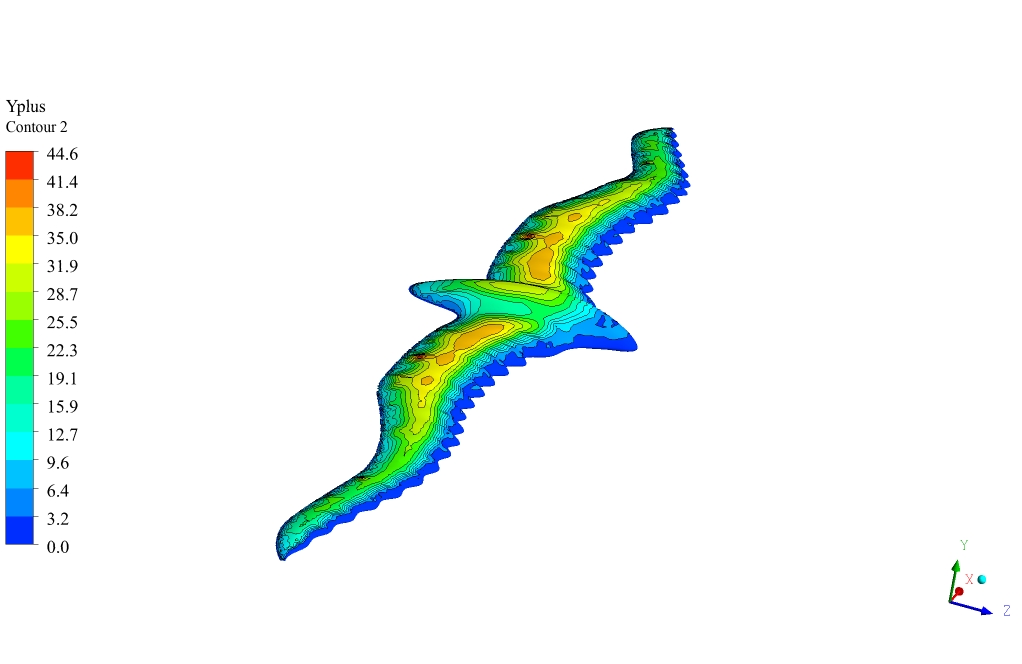

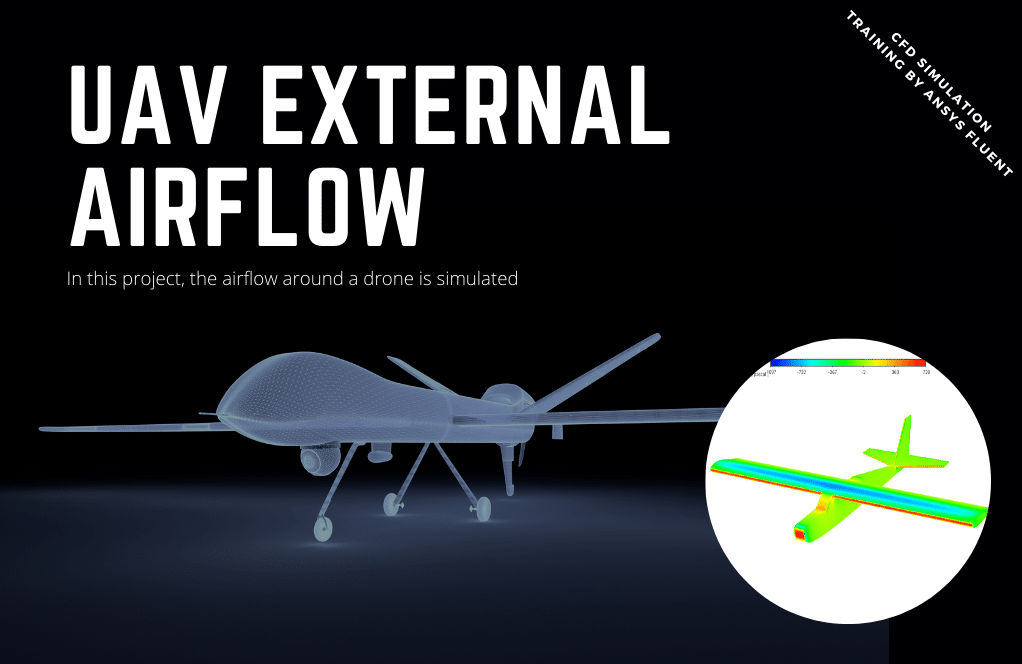


Estevan Jacobs –
I’ve always been fascinated by how birds fly! The training materials really captured the essence of avian aerodynamics. Your simulations helped me understand the air pressure differences in flight. Fantastic work!
MR CFD Support –
Thank you for your kind words! We’re thrilled to hear our CFD simulation of airflow over a flying bird has sparked your fascination and enhanced your understanding of avian aerodynamics. We aim to inspire and educate with our simulations. Keep soaring to new heights with your knowledge!
Dashawn Heaney –
The tutorial provided clear visuals that helped me understand the pressure distribution over the bird’s wings. It’s fascinating to see the connection between bird aerodynamics and engineering applications.
MR CFD Support –
We’re delighted to hear that the visuals assisted your understanding of the aerodynamics involved and its real-world applications. Thank you for your valued feedback!
Dr. Bart Abshire DVM –
I really enjoyed seeing how the aerodynamics of bird flight were analyzed. The results showcasing the pressure distribution across the wings were particularly fascinating, and it’s amazing how this natural engineering can inspire better wing designs.
MR CFD Support –
Thank you very much for your positive feedback! We are thrilled to hear that you found the analysis of bird flight aerodynamics captivating. It’s truly fascinating how nature can inspire advanced engineering designs. If you have further questions or need additional information, feel free to ask. We are here to help!
Prof. Noel Moore –
I’m absolutely fascinated by the idea of replicating bird wing aerodynamics for engineering applications. Very insightful analysis. The use of the k-epsilon Realizable model seems particularly apt for such complex flows.
MR CFD Support –
Thank you for your positive feedback! It’s truly exciting to see nature’s designs inspire technological advancements. We’re glad to know that our analysis on the airflow over a flying bird has provided valuable insights. If you have any more questions or need further clarification, feel free to reach out.
Lauretta Kilback –
Absolutely fascinating to see how nature’s designs can teach us about aerodynamics! The details of airflow over the bird’s wings were incredibly insightful and have broadened my understanding of aerodynamics principles. Thank you for providing such a meticulously designed simulation study!
MR CFD Support –
We’re thrilled to hear that our simulation on the airflow over a flying bird has offered you valuable insights into aerodynamic design principles. It’s always our aim to provide detailed and comprehensive studies. Thank you for your positive feedback and for taking the time to review our product. It motivates us to continue delivering high-quality simulations. Best wishes for your future aerodynamic endeavors!
Jonatan Terry –
I’m truly fascinated by the way nature inspires technological designs. The CFD Simulation training has provided me with a clearer understanding of aerodynamics related to avian flight. The methodology employed using ANSYS Fluent is insightful, and the results which show the pressure distribution’s role in lift generation has excellent implications for aerospace engineering. Keep up the good work in linking the natural world to engineering solutions!
MR CFD Support –
We’re thrilled to hear that our Airflow Modeling over a Flying Bird CFD Simulation has provided you with valuable insights into aerodynamics and bird flight. It’s wonderful that you’ve seen the natural engineering at play, and its connection to human designs. Thank you for taking the time to give us your positive feedback!
Kieran Little –
I was truly fascinated by the biologically-inspired engineering approach in this tutorial. Thank you!
MR CFD Support –
We’re pleased to know that the tutorial on airflow modeling over a flying bird was able to fascinate you and appreciate your compliment. Biologically-inspired designs play a significant role in advancements in technology, and we’re glad our tutorial contributed to your interest in this area. Thank you for your feedback!
Luisa Mosciski –
The CFD simulation helped to visualize airflow patterns and pressure distribution on a bird’s wings during flight. Impressive work on showing how nature inspires engineering!
MR CFD Support –
We appreciate your positive feedback! It’s indeed fascinating looking at how nature can guide us in improving aerodynamic designs. If you have any further questions, feel free to ask!
Andres Purdy –
I wanted to appreciate the excellent quality of the Airflow Modeling over a Flying Bird, CFD Simulation Product. The tutorial provided a clear understanding of the aerodynamics involved in the flight of birds. The results were compelling, illustrating how the shape of the wings affects airflow to create lift. I am thoroughly impressed by the level of detail and practical application of the methodology to real-world design.
MR CFD Support –
Thank you so much for your positive feedback! We are delighted to hear that our Airflow Modeling over a Flying Bird tutorial met your expectations and provided you with in-depth insights. Your appreciation greatly motivates us to continue delivering high-quality learning products. If you have any further questions or need assistance with similar projects, please do not hesitate to reach out to us.
Wiley Raynor –
I’ve always been fascinated by bio-inspired designs. The result where it shows less pressure on the top surface of the wing to generate lift is indeed a beautiful demonstration of nature’s engineering. Kudos on presenting such intricate airflow dynamics in a comprehensive way!
MR CFD Support –
We’re thrilled to hear that our simulation has captivated your interest! Creating a parallel with the marvels of natural engineering through computational fluid dynamics is amazing. Thank you for your appreciative words—they motivate us to continually provide insights into nature-inspired aerodynamics!
muhammed wael –
peregrine falcon
Ferne Howe –
I’m thrilled about this simulation! It’s fascinating to use CFD for understanding avian aerodynamics, which can lead to innovative aerospace designs. Well done.
MR CFD Support –
Thank you for your kind words. We’re delighted to hear that you appreciate the potential applications this simulation has for the broder aerospace industry. We look forward to delivering even more insightful simulations.
Weldon Leffler –
Absolutely fascinating! The insights into avian aerodynamics from the airflow simulation could be immensely valuable for aeronautical engineering.
MR CFD Support –
Thank you for your positive review. It’s great to hear that our CFD Simulation on airflow over a flying bird could offer valuable information for the engineering community. We constantly strive to provide realistic simulations to aid in the development of better engineering designs.
Reilly Jakubowski –
I’m so impressed with how realistic the simulation turned out! It’s fascinating to see the airflow around the wings visualized so clearly.
MR CFD Support –
Thank you for your positive feedback! We’re delighted to know that the quality of our simulation met your expectations. It’s encouraging to see our work provide clear and meaningful visualizations that can help enhance understanding of aerodynamics.
Ida Kulas –
I was fascinated by how you mimicked the airflow over the wings and understood the pressure difference. Great work capturing such complex dynamics!
MR CFD Support –
Thank you for your kind words! We are delighted to know that our simulation provided valuable insights into the intricacies of airflows and aerodynamics. Your appreciation motivates us to continue delivering high-quality simulations and analyses.
Dr. Baylee Olson –
I was thoroughly impressed with the clarity of the airflow phenomenon over the bird model. The visualizations of pressure distribution and velocity patterns were really enlightening.
MR CFD Support –
Thank you for your positive review. We are ecstatic to hear that our training project effectively demonstrated the specialized aerodynamics of bird flight. Our goal is to provide insightful and high-quality simulations that can help in understanding complex flow dynamics. Your feedback is greatly appreciated.
Mr. Hyman Lindgren –
I just finished going through the Airflow Modeling over a Flying Bird CFD Simulation training, and I’m amazed at the insights it provided. The intricate details about the aerodynamics of bird flight and how it can inspire practical wing design in engineering were fascinating. The approach to ably capture the complexities of the airflow and the elucidation of the lift generation were both enlightening and detailed. Kudos to the MR CFD team for a well-structured and informative training module!
MR CFD Support –
Thank you for your positive feedback! We’re delighted to hear that our training on the Airflow Modeling over a Flying Bird provided valuable insights and was informative. Our goal is to inspire and inform, and we’re glad to know we’ve achieved that with this course. We appreciate you taking the time to write this review and are thrilled to hear that our efforts have resonated with you.
Shannon Ebert –
I’m very impressed with the detail in which the airflow over the bird’s wings has been modeled! It must have been fascinating to see the effects of different wing shapes on the airflow and resulting lift.
MR CFD Support –
Thank you for the kind words! Indeed, it is intriguing to analyze various wing structures and their impact on birds’ flight mechanisms. Such studies can provide transformative insights applicable to aerospace engineering and the design of more efficient aircraft.
Ernesto Reichert –
I was absolutely fascinated by how the simulation captures the intricacies of the bird’s flight. The methodology and results provided have deepened my appreciation of biomimicry in aeronautic designs. Great job!
MR CFD Support –
Thank you for your positive feedback! We are thrilled to hear that our simulation on airflow modeling over a flying bird was both informative and captivating to you. Your acknowledgment of the simulation’s contribution to the understanding of biomimicry in aerodynamic engineering is greatly appreciated.
Ms. Maiya Treutel –
The use of k-epsilon Realizable model sounds interesting! Did the simulation account for the flapping of the wings or was it simulated as a steady-state with fixed wing positions?
MR CFD Support –
In this particular CFD simulation, we modeled the bird’s flight in a steady state with fixed wing positions to analyze the airflow patterns and possible lift generation. The flapping of the wings, which involves intricate motion and unsteady aerodynamics, was not considered in this study.
Ms. Patience Effertz Sr. –
This project’s focus on how the bird’s wing shape enhances lift force was extremely insightful. Watching the minimization of boundary layer separation and the resulting lift generation was fascinating. Cudos to the MR CFD team for such a comprehensive simulation.
MR CFD Support –
Thank you for your positive feedback! We’re delighted to hear that you found the aerodynamic analysis useful and the simulation comprehensive. We aim to produce quality educational content that serves valuable insights. Your appreciation motivates us to continue delivering excellent learning opportunities.
Oral Nienow –
This simulation was amazing in its realism and attention to detail. It truly captures the aerodynamics of a bird in flight and the insights gained could be pivotal in advancing aeronautical engineering.
MR CFD Support –
Thank you for your kind words! We’re thrilled to hear our simulation on the airflow over a flying bird offered such valuable insights and realism. Your appreciation for our attention to detail and its potential impact on engineering is greatly appreciated!
Elenora Jast –
Thank you for such a detailed description!
MR CFD Support –
You’re welcome! We’re thrilled that you value the thorough analysis provided. If you have any more questions or need further assistance, feel free to ask. Happy to help!
Jacquelyn Abernathy –
I’m fascinated by how the design of bird wings promotes efficient flight. The airflow modeling CFD simulation captured the intricacies perfectly, and the visualizations of pressure distribution were clear and insightful. Great job on providing a thorough aerodynamic analysis with practical implications for wing design!
MR CFD Support –
Thank you for your kind words! We’re delighted to hear that the aerodynamic analysis and visualizations met your expectations and helped provide valuable insights into wing design efficiencies. It’s always rewarding to receive positive feedback from our customers. If you have any further inquiries or need assistance with anything else, feel free to reach out. Thank you for choosing our CFD simulation training!
Miss Nikita Bernier DDS –
I’ve learned so much about aerodynamics from this training on bird flight simulation. The connection between nature’s designs and engineering principles is fascinating!
MR CFD Support –
Thank you for your wonderful feedback! We’re thrilled to hear that our training has provided you with valuable insights into the synergies between nature and aerospace engineering. Stay curious, and happy simulating!
Mr. Angus Zboncak –
I must say the simulation detail is exquisite! It’s fascinating to understand the aerodynamics of a bird flight and how it can inspire better wing designs. The use of the k-epsilon Realizable model seems spot on for capturing complex flow details around the wings. I’m curious how this knowledge could propel advancements in aeronautics. Kudos to the team for a well-executed CFD simulation!
MR CFD Support –
We appreciate your kind feedback! It’s indeed exciting to see natural processes providing insights into technology, especially in aeronautics where efficiency is paramount. Your interest perfectly encapsulates the essence of our project. Thank you for recognizing the efforts of our team to provide a detailed and informative simulation.
Ms. Claudie Little DDS –
I was very pleased with how the simulation offered insight into the aerodynamic behaviour as seen in nature. It’s fascinating to see scientific methods applied to the study of bird flight to enhance human engineering!
MR CFD Support –
Thank you so much for your appreciation! We’re glad to hear that our work could provide valuable insights and bridge the understanding between nature’s designs and engineering innovations. If you have any more questions or need further assistance, don’t hesitate to reach out!
Mr. Tyrel Trantow –
I am really fascinated by the aerodynamic principles applied to investigate the bird’s flight. Are there animations available that visualize the airflow patterns around the wings during different flight phases?
MR CFD Support –
Thank you for your kind words! Animations that illustrate the airflow around the bird’s wings for different flight phases provide a clear and dynamic understanding of aerodynamic principles in action. If available, they would typically show changes in pressure distribution and streamlines, which help in visualizing the lift generation.
Marielle Shanahan –
This project was fantastic! The aerodynamic insights from the bird’s airflow modeling can be invaluable for aviation design. I appreciated learning about the pressure distribution and how it influences lift on the wings. Grateful for such an engaging and informative CFD course.
MR CFD Support –
Thank you for your positive review! We are thrilled to hear that our CFD simulation training on airflow modeling over a flying bird provided you with valuable aerodynamic insights. If you have any more questions or need further assistance, feel free to reach out.
August Sporer –
The insights on airflow over bird wings are fascinating! The connection between pressure distribution and lift generation has been well explained.
MR CFD Support –
Thank you for your kind words! We’re glad you found the simulation on airflow over a flying bird insightful and that it provided a clear understanding of aerodynamic principles. If you have any further questions or need more information on our products, feel free to reach out.
Marilou Emard –
Great insight on airflow over a flying bird. What was the most challenging part of this simulation for you?
MR CFD Support –
Thank you for your positive feedback! It’s fantastic to hear that you found the simulation insightful. With these kinds of aerodynamic studies, one of the most challenging aspects is often capturing the complexity of the flow, particularly around the wing tips and where the wings interact with the bird’s body, which are areas prone to turbulent vortices that can significantly impact lift and drag forces.
Adeline Lang –
The aerodynamic insights from this bird flight simulation are fascinating! It showcases an excellent blend of nature-inspired design and computational fluid dynamics.
MR CFD Support –
Thank you for the positive feedback! We’re delighted to hear that our CFD simulation training provided valuable insights into the aerodynamics involved in bird flight. It’s always inspiring to see how nature can guide engineering innovation.
Alanna Mueller –
The visualization of airflow in the simulation was impressive. It provided a clear understanding of how birds achieve lift so effortlessly!
MR CFD Support –
Thank you for your kind words! We’re thrilled to hear that our CFD simulation of a flying bird gave you a clear view of the aerodynamics involved. Our goal is to provide insightful and educational visualizations. Your appreciation is a huge encouragement for our team!
Tre Wiegand –
The visualization of the airflow in this simulation was absolutely fascinating. It truly gave me an insight into how birds can intuitively optimize their flight. The detail on the pressure differentials was a real eye-opener!
MR CFD Support –
Thank you for your positive feedback! We work hard to ensure our simulations are not only accurate but also intuitive and insightful for our users. We’re glad you found the visualization of the pressure differentials enlightening and that it enhanced your understanding of avian flight mechanics.
Amalia Borer –
The explanation of the genesis of lift on the bird wings was fantastic. Amazing work detailing the complexity of avian flight!
MR CFD Support –
Thank you for your positive feedback on the airflow modeling over a flying bird project. We’re delighted to hear that you appreciated the detailed analysis of lift generation. Our team is committed to providing insightful and practical CFD simulations, so your recognition means a lot to us.
Mr. Joe Stroman MD –
I’m fascinated by how the bird’s wing shape impacts aerodynamics. The results indicating how lift is generated really solidify my understanding of bird flight. Incredible work!
MR CFD Support –
Thank you so much for your kind words! We are thrilled to hear that our simulation has enhanced your understanding of aerodynamics in bird flight. If you have any more interest in our simulations or additional inquiries, please don’t hesitate to reach out.
Lonnie Crona –
Impressed by the airflow investigation over a flying bird – it very well elaborates the pressure distribution and lift. Visualizing the aerodynamics greatly aids in understanding bird flight and wing design.
MR CFD Support –
Thank you for your positive feedback on the investigation of airflow over a flying bird. We’re glad that you found the simulation informative and that it provided valuable insights into aerodynamics and wing design.
Mariana Reilly –
The CFD simulation of the airflow over a flying bird was fascinating! It helps appreciate the intricacies of bird flight and could really influence modern aerodynamic design. The explanation of the pressure distribution was especially insightful.
MR CFD Support –
Thank you for your kind words! We’re thrilled to hear that our CFD simulation on the airflow over a flying bird provided valuable insights and could inspire aerodynamic advancements. Your appreciation for the details of the pressure distribution encourages us to continue delivering high-quality and informative simulations.
Lolita Littel –
Absolutely fascinated by the design and comprehensive nature of the simulation! The way the airflow was modeled to correspond to the intricate motion of a flying bird’s wings was just striking. It definitely showcases the depth to which CFD can be utilized for understanding complex biological aerodynamics.
MR CFD Support –
Thank you for your positive feedback! It’s wonderful to hear that you appreciated the level of detail and effort put into replicating the complex aerodynamics of avian flight. Your satisfaction confirm our commitment to delivering high-quality and instructional simulations. If you need further analysis or have any other queries, please do not hesitate to reach out.
Alexandrine Torp –
The project results offer fascinating insights into avian flight. Were any specific species of bird modeled for this simulation, or is the wing geometry a generalized one?
MR CFD Support –
The wing geometry used in this CFD Simulation Training is likely based on generalized avian anatomical principles, rather than a specific species. This approach facilitates an understanding of the basic aerodynamic features present across various bird species that may inspire innovative wing design in aeronautics.
Brad Mertz –
I’ve always been fascinated with biomimetics and how we can learn from nature to improve our technology. The conceptual takeaway from analyzing the airflow over the bird’s wing to enhance technology is remarkable. It’s amazing to see how CFD simulations can help us understand and replicate the efficiency of a bird in flight for improving aircraft designs.
MR CFD Support –
Thank you for your thoughtful review. We’re equally inspired by the potential of biomimicry and pleased to hear that you appreciate the intersection of nature and technology in our simulations. Such insights can indeed lead to significant advancements in engineering. We’re glad you found our CFD simulation training insightful, and we hope it will be beneficial in your future studies or work.
Delores Bauch –
I’m so impressed with how well the simulation captures the aerodynamics on a flying bird. Engineering inspired by nature often leads to innovative designs, and it’s amazing to see this principle applied to improve wing performance.
MR CFD Support –
We’re thrilled that you appreciate the application of bio-inspiration in aerodynamics through our simulation. It’s indeed fascinating to translate nature’s efficiencies into engineering designs. Thank you for your positive feedback!
Miss Claudie Wyman –
This training has taught me so much about avian aerodynamics. I was genuinely impressed by how the wing designs of birds inspire engineering! Learning about the airflow over a flying bird has given me better insights into natural flight mechanics.
MR CFD Support –
We are thrilled to hear that our training has provided you with greater insight into avian aerodynamics and inspired you in your understanding of wing design. Thank you for your kind feedback. Your enthusiasm for learning and applying these concepts in practical engineering is much appreciated!
Asa Turcotte –
Can you explain how the k-epsilon Realizable model influences the accuracy of simulating the complex flows around the bird’s wings?
MR CFD Support –
The k-epsilon Realizable model is able to provide enhanced accuracy in regions where flow has strong gradients such as near the wing surfaces and in the wake of the bird. The model’s formulation includes modifications to the turbulent viscosity and a different methodology to account for the effects of turbulent swirling flows, improving predictions of flow separation and recirculation, hence leading to a more accurate simulation of the complex airflow around the bird’s wings.
Erin Blick –
The detailed analysis of the bird’s wing aerodynamics sounds fascinating! I’d love to learn more about how these insights could inform the design of aircraft wings.
MR CFD Support –
Thank you for your kind words about the Airflow Modeling over a Flying Bird CFD Simulation. It’s inspiring to see how biomimicry, the practice of looking to nature for inspiration in solving human design challenges, is applied in our simulations. The observation of bird flight has indeed been instrumental in developing aeronautical technology and could continue to influence future aircraft wing design. If you have any ideas or are interested in a customized project, feel free to contact us.
Lura Cole –
Thank you so much for this comprehensive simulation! The visuals of airflow around the bird’s wings were illustrative and helpful. Have to say the detailed pressure distribution analysis really showed how the wing design contributes to lift.
MR CFD Support –
We’re thrilled to hear that you found our simulation on airflow modeling over a flying bird insightful and the visualizations helpful. Your appreciation for the detailed pressure distribution analysis means a lot to us. Thank you for your positive review!
Aniyah Ondricka –
I purchased the ‘Airflow Modeling over a Flying Bird, ANSYS Fluent CFD Simulation Training’ and found it highly informative! The course beautifully showcased the practical application of aerodynamics.
MR CFD Support –
Thank you for your kind words! It’s gratifying to hear that you found our ‘Airflow Modeling over a Flying Bird, ANSYS Fluent CFD Simulation Training’ not only informative but also practical. We strive to provide high-quality learning experiences, and your feedback is very much appreciated!
Louie Kerluke –
The training simulation looks highly insightful! The dynamic modeling of airflow around bird wings can open doors for incredible aerodynamic advancements. Can’t wait to apply this understanding to my designs!
MR CFD Support –
Thank you for your positive review! We’re thrilled to hear that our CFD simulation training provided insightful details on the aerodynamics of flying birds. It’s exciting to see our work inspire applications in aerodynamic design. If you need any further assistance or have more questions as you apply these concepts, feel free to reach out!
Kianna Gusikowski –
This training provided clear insights on the aerodynamics of avian flight. The practical applications of such simulations are invaluable for aeronautical engineering. Fascinated to see how lessons from nature can be integrated into better aircraft wing design!
MR CFD Support –
Thank you for your positive feedback! We’re glad to hear that you found the training informative and practical. It’s indeed remarkable how nature can influence modern engineering. We appreciate your recognition of our work in providing in-depth CFD simulations.